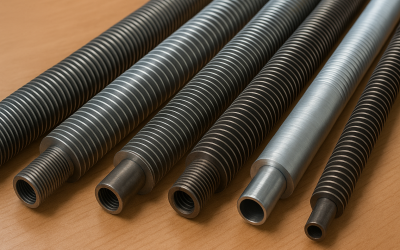Blog
Industry trends, technical insights, and company news from the world of heat exchanger tubes and plates.
Finned Tubes: Designs, Advantages, and Selection Guide
Finned tubes increase heat transfer efficiency by adding external surface area. There are 8 main types of finned tubes: G-Fin, L-Fin, KL-Fin, LL-Fin, Crimped, Extruded, Integral Low-Fin, and Welded. Each type differs in construction method, temperature tolerance,...
Which Industries Use Copper Alloy Tubes the Most?
Electrical sector (~35 %): Dominates demand with busbars, connectors, transformer cooling coils, and grounding systems—leveraging copper’s unmatched electrical conductivity and reliability. Transportation (~25 %): Used in automotive and EV radiators, battery coolant...
Admiralty Brass: Composition, Properties, and Applications
Exceptional dezincification-resistant brass composition for reliable marine and industrial performance. Optimal balance of mechanical strength (310–380 MPa) and thermal conductivity (110 W/m·K) for heat exchanger tubing. Proven lifecycle cost savings (25–40%) and full...
Differences Between CuNi 90/10 and CuNi 70/30
CuNi 90/10 is cost-effective and offers good corrosion resistance and thermal conductivity — ideal for standard marine piping and heat exchangers. CuNi 70/30 provides higher strength and superior resistance in aggressive or high-velocity seawater environments —...
Why is Eddy Current Testing (ECT) Used Instead of Hydrostatic Testing Under ASTM B111 for Non-Destructive Testing (NDT)?
Eddy Current Testing (ECT) is preferred over Hydrostatic Testing under ASTM B111 because it detects early-stage defects like cracks, corrosion, and thinning before a leak occurs, making it ideal for preventive maintenance. ECT is faster, non-destructive, and provides...
A Guide to Copper-Nickel Tubes: Properties, Applications, and Benefits
Copper-nickel (CuNi) tubes are widely used in marine, industrial, and HVAC applications due to their corrosion resistance, high thermal conductivity, and durability. These tubes are ideal for seawater cooling, heat exchangers, and oil and gas operations. Advantages...





